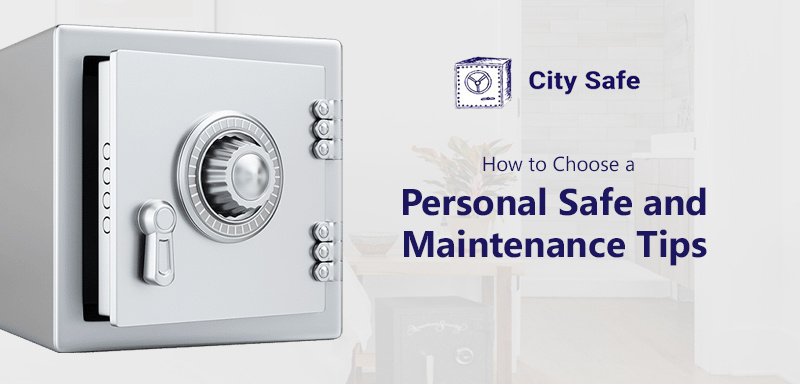

Do you ever worry about keeping your personal items safe? Whether it’s important documents, valuable jewelry, or other items of significance, maintaining a safe environment for your belongings is an essential part of personal security. But how do you ensure that your possessions are properly protected? Here’s how to maintain your personal safe and keep unwanted visitors out.
The first step in maintaining your personal safety is to purchase a quality safe. There are several different types available on the market today, so it’s important to do your research and find one that meets your needs and budget. Look for features like fire resistance and waterproofing in order to make sure that all your valuables are kept secure.
It’s also important to regularly check the condition of your safe. Ensure there isn’t any visible damage or tampering that could signal potential break-ins. Consider investing in additional security measures such as alarms or electronic locks to further protect against theft or unauthorized access. By taking these steps, you can be sure that all your possessions are secure from harm and intruders.
A personal safe is a secure storage unit that helps keep your important items and documents protected from theft, loss, or damage. It’s typically made from metal and is designed to be resistant to fire, water, and other environmental hazards. A personal safe can range in size from small, portable models to larger units that are meant for use in the home or office.
When choosing a personal safe, it’s important to consider what type of items you plan on storing inside. Some safes are designed to store jewelry, guns, cash, or other valuable items securely, while others may be more suited for documents like birth certificates or financial records. Additionally, there are various locking mechanisms available, such as keyed locks, combination locks, and biometric locks, that allow you to choose how you want your safe secured.
Once you’ve picked the right size and locking system for your needs, you should take care of your personal safe often. This means checking the lock and hinges for any signs of wear or damage and making sure the interior remains dry and free of dust or debris. It’s also important to use common sense when installing or relocating your safe—make sure it’s placed in an area that offers limited access and is out of sight from potential burglars. Taking these steps will help ensure that your personal valuables always remain secure.
When it comes to protecting your valuables, there are several types of personal safes available. These include wall safes, floor safes, fireproof safes, and biometric safes. Each type has its own advantages and disadvantages that should be taken into consideration when deciding which one is best for you.
Wall safes are a great option for those who want to keep their items safe without taking up too much space. These are installed directly into the wall, making them easy to hide from prying eyes. They come in various sizes and can range from small to large, depending on what you need to store away. The downside of wall safes is that they can be quite difficult to install and may require professional help if you don’t have experience with installation.
Floor safes offer more security than wall safes due to their hidden location beneath the flooring in your home or office. They can also be quite heavy, making them difficult for thieves to move around or carry out of the building. But these are more expensive and harder to install than wall safes.
If there is a fire in your home or office, a fireproof safe gives you an extra layer of protection against the flames. They’re made from thicker metal walls that can withstand high temperatures and protect your documents and other important items from damage due to heat or smoke. On the other hand, these are much pricier than other types of personal safes and may not be suitable for everyone’s budget.
Biometric safes use fingerprint recognition technology instead of keys or codes as a way of unlocking them. This adds an extra layer of security because each time someone wants to get into the safe, they must scan their own fingerprint. The downside is that biometric scanners could malfunction at times, making it difficult for you to open your safe when it’s needed most.
No matter which types of personal safe you choose, it’s important that you maintain it properly by regularly checking the locks and hinges for any signs of wear and tear or damage so that it works effectively when needed. Additionally, make sure that all parts are securely fastened together before using your safe so as not to compromise its overall security features either accidentally or intentionally by intruders.

When it comes to personal safety, the placement of your safe is just as important as the safe itself. Where you keep your safe can have an impact on its security and your access to it. Here are some tips for finding the best location for your safe:
First, consider where you would most likely need access to the valuable items inside. If you’ll be using the safe frequently, placing it in a convenient spot near a main entrance or in a closet may be ideal. However, if you don’t plan to access it often, then keeping it out of sight and in an inconspicuous area may be best. Keep in mind that if someone else knows where your safe is located, they could potentially access its contents, so make sure to keep this information secure.
Another factor to consider when choosing a location is whether or not it’s fireproof or waterproof. If there’s potential for either of these occurrences at your home or office, then make sure to select an area that won’t be affected by them. Fireproof safes are designed with heat-resistant materials that can protect their contents from high temperatures; similarly, waterproof safes are made with sealants and airtight seals that will help keep water away from their contents.
Finally, consider how secure the area around your safe is. Choose a spot that won’t be easily accessible by others who shouldn’t have access, such as family members or strangers. It’s also important to make sure that you can securely attach the safe to something sturdy like a wall or floor so that it won’t be easy for someone else to move it and take it away without your knowledge.
By thinking about all these things when deciding where to put your personal safe, you can make sure it is safe and easy to get to when you need it.
Once you have determined the appropriate location and placement of your safe, it’s time to consider the security features that you should look for. While there are many different types of safes available on the market, some offer more robust security than others. Here are a few key features to look for when selecting a safe:
First, look for a safe that has strong steel construction. Steel is much more difficult to breach than other materials, and it will provide an added layer of protection against break-ins or burglaries. Make sure that any steel components are appropriately reinforced with rivets or welds as well.
Next, consider getting a safe that has multiple locking mechanisms. The more locks, the better; this will increase the difficulty of unauthorized access even further. Look for safes that have combination locks, electronic locks, or even biometric locks (fingerprint scanners) if desired.
Finally, make sure that your safe is fireproof or fire resistant. Fire can be just as destructive as a burglar if not properly protected against. A good fireproof safe should be able to withstand temperatures up to 1,700 degrees Fahrenheit and protect its contents from smoke damage as well. Investing in a high-quality fireproof safe is essential for keeping your items safe in case of an emergency.

The first step in setting up your personal safe is to determine where you are going to put it. Consider the security of each location and how easy it will be for you to access. If possible, choose a spot that requires two different keys or codes so that only you can open the safe. Additionally, you should make sure the safe is heavy enough that it cannot be easily moved.
Once you have chosen a location, decide which type of safe will best suit your needs and budget. There are many types available, including fireproof, waterproof, and combination safes. When making your decision, consider what type of items you plan to store in the safe and budget. There are many types available, including fireproof, waterproof, and combination safes. When making your decision, consider what type of items you plan to store in the safe. It’s also a good idea to check with your insurance provider to see if they offer any discounts for installing a secure safe.
When your new safe arrives, make sure to follow all installation instructions carefully before using it. Be sure to change the locks or code on the safe as soon as possible so no one else has access to it. Finally, test out your new system several times before trusting it with valuable items or documents.
When it comes to keeping your personal safe secure, the type of lock you choose is essential. There are several options available, ranging from combination locks to keyed locks. Combination locks are typically less expensive and come in a variety of sizes and styles. They’re also easier to operate since they require no key. Keyed locks, on the other hand, offer more security because they require a specific key to open them.
For added security, you may want to consider a biometric lock. These types of locks use fingerprints or retinal scans for access and are great for high-security situations. You can also get locks that have multiple levels of access so that only certain individuals can access certain areas or items within the safe.
No matter which types of lock you choose, make sure that it’s made from strong materials and that it’s installed properly by a professional. This will ensure that your valuables are protected from potential intruders and thieves. Furthermore, make sure to change the combination or key code regularly and store any spare keys somewhere secure where they won’t be lost or stolen. Taking these precautions will help keep your personal information always secure.
Now that you’ve chosen the lock type that’s best for your needs, it’s time to focus on maintaining your personal safety by changing the combination code. It’s important to do this periodically, as old codes can become compromised over time.
First and foremost, you’ll want to make sure you have a secure location to store the new combination code. Make sure it is somewhere that only you know about and can access easily. You should also make sure there is no way anyone else could guess the combination code or find out what it is.
When it comes to changing the combination code, it’s a simple process. All you need is a pen or pencil and the instructions that came with the lock. Follow these instructions step-by-step, making sure that any notes you write down are kept in a secure place. Once you’ve changed the combination code, test it several times to ensure that it works properly and safely locks when needed.
To sum up, changing your combination code regularly is an essential part of maintaining personal safety and security. Take precautions to ensure your new code remains safe from everyone but yourself and test its functionality frequently for added protection.
A regular maintenance schedule is essential to keeping your personal safe in top condition. It’s important to stick to a routine, checking the lock and hinges monthly, along with any other moving parts like keys or combination dials, if applicable. This will help ensure that your safe remains secure and its contents are protected.
When it comes to cleaning and general upkeep, a damp cloth can be used for wiping down the exterior of the safe. Use caution when cleaning the interior of your safe; never use harsh chemicals or abrasive materials as this could damage its protective coating or corrode its surface.
It’s also important to make sure that your personal safe is placed in an area where it won’t be exposed to extreme temperatures or humidity. Store it away from direct sunlight and always keep it out of reach of children. By taking these preventative steps, you can ensure that your valuables remain secure and protected for years to come.
If you encounter any problems with your safe, the first step is to identify what type of problem it is. Is your safe not opening? Is there a strange noise coming from it? Are the locks malfunctioning? Knowing what the issue is will help you troubleshoot it and get back to normal quickly.
The next step is to refer to the instruction manual that came with your safe. It often contains information on troubleshooting common issues, so check there first. If this doesn’t resolve the issue, contact a qualified locksmith or the manufacturer’s service center for assistance. They can help determine whether there is an underlying problem that needs to be addressed.
Finally, keep in mind that regular maintenance and cleaning of your safe will help prevent most issues from occurring in the first place. Make sure all moving parts are lubricated regularly and check for signs of wear and tear such as rust or corrosion. This will extend the life of your safe and ensure it works properly for years to come.
Moving on from troubleshooting issues, professional services like City Safe and Vault can help you maintain your personal safety. Our services range from regular safe maintenance to emergency lockouts. It’s important to find a reliable service provider who is experienced with the type of personal safes you have.
For details on our services, visit our website. You can be confident that you are working with a reputable company that can deliver high-quality work and customer service because we have thousands of satisfied customers. We are also upfront about all costs associated with the services, so there are no surprises when it comes time to pay the bill. We stand behind our work and are a call away just in case any repairs are needed down the line.
City Safe and Vault can help keep your personal safe functioning properly over time, giving you peace of mind that your valuables are secure.
The decision to purchase a personal safe is an important one. It can cost anywhere from a few hundred dollars to thousands of dollars, depending on the size and security features. It’s also important to make sure your safe is waterproof in case it gets exposed to moisture. And if you plan on moving your safe, you should invest in a secure way to transport it, so it doesn’t get lost or stolen.
Lastly, you should consider bolting down your personal safe if you want it to be extra secure. This way, if someone tries to break in or steal it, they’ll have a much harder time doing so. Furthermore, if you forget the combination code for your personal safe, then there are ways to reset or recover the combination, depending on the lock type and manufacturer of your safe.
All in all, purchasing and maintaining a personal safe requires considerable thought and research before making an informed decision. If done properly, your personal safe will be both secure and provide peace of mind knowing that all your valuables are stored securely within its walls.
“When my safe with many important documents in it wouldn’t open, I got anxious and googled several different ways… Left a couple messages and never heard anything back. Then I found City Safe – they came the same day. They completely fixed everything!!! City Safe rescued us! Thanks so much!”

“They completed the lock replacements and repair fast! So happy I worked with them! The price is great! Very reasonable! Will use them again in the future!”

“Responded to my call right away! Thank goodness for you guys! Didn’t know I needed repair on my locks and that they needed maintenance every now and then! They provided a professional and good value service and I got a consultation for free. Do not hesitate to work with them!”

“Got locked out of my jewelry safe, it wouldn’t open and it made so anxious! Called City Safe and I am so glad that they respond immediately! They saved the day and recommended me some maintenance methods. Beyond grateful! Highly recommend!”

“They completed my repair and maintenance so fast! Didn’t expect that! So glad I worked with experts! Very reasonable price too! Thanks guys!”

“Woah! I didn’t know my safe needed repair that’s why I got locked out! I knew I had to properly maintain it but I didn’t know how and the guys from City Safe helped me out, a lot! They provide professional and good value service! You also get a consultation for free!!! Would recommend to family and friends! ☺”

“Got so worried how to move my safe without damaging my floor! I didn’t want to pay for the damage! City Safe saved the day and helped me all throughout the entire process. Beyond grateful for this! Recommended you guys to my family and friends!”

“I planned to move out but didn’t know what to do with the safe I have. It’s large so I was not certain of the process of moving. I called City Safe and they were glad to help! So thankful for them! No damages and I was able to transfer it to a recommended area in my new place!”

“ They provide professional and good value service! You also get a consultation for free!!! Would recommend to family and friends!”

“After losing my keys right sometime recently my greatest assembly of the year, I thought it was the conclusion of the world. I looked for a Locksmith in New York and called City Secure instantly. Realizing my crisis, a locksmith arrived in less than 30 minutes and was able to grant me about quick get to my supplies. I was so inspired by the incite benefit that I called them back after my assembly to supplant the locks at my office. Predominant, incite and dependable benefit earned my trade for life!”

“Changed keys and locks again for security purposes. City Safe always sends technicians that are super knowledgeable, and most importantly, honest and reliable!”

“Clear, concise explanation of the system and provided helpful tips for its maintenance as well. Will highly recommend this team!”











Provided to all neighborhoods in New York.
We will make sure you are happy with our service
On all safes sold. City Safe provides a warranty for all service
We will ship your safe to almost every state